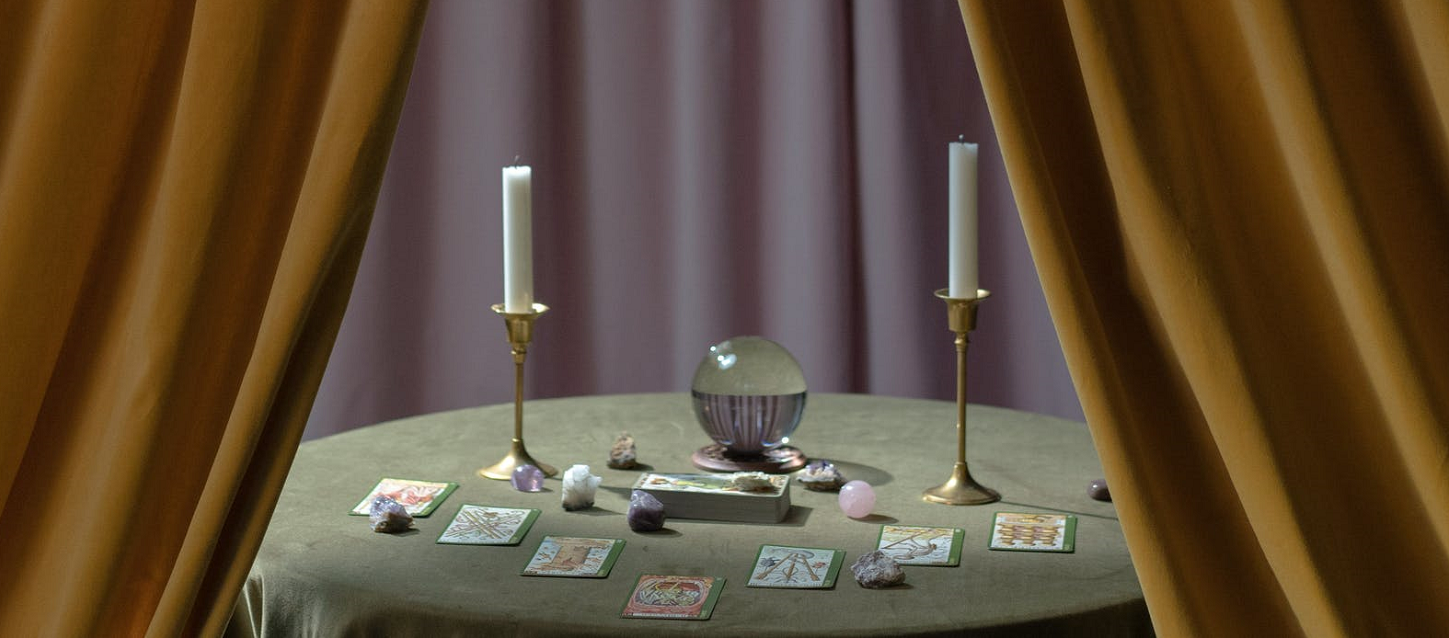A few years ago, I was cast as a character linked to the paranormal in a Victorian game played over several instalments. The organisers allowed us to choose our own preferred play-style and specialisation. I quickly decided that I wanted to play a character who led seances. I was interested in exploring themes of real mysticism against fake seances. I wanted to use a very visual way of running the scenes and decided that I wanted to do something using fortune-telling cards or tarot.
Playing the expert
My character was supposed to be an expert on the subject of card readings. She did both real readings with the intention to actually help the subject and fake ones, which were merely used to tell the rich customers what they wanted to hear. Initially, I thought to bring a regular tarot set to the game, but I quickly stepped away from that idea for two reasons;
- I was not an expert on tarot. It would have been an option to study regular tarot cards very thoroughly, but I knew that there would likely be more knowledgeable players around.
- Many people object to the use of real tarot sets at games. After all, for many people tarot actually serves a purpose akin to religion so it is not necessarily right to bring a real tarot set to a game. I wanted to respect this.
For a while, I debated whether a store-bought card set would work fine for my purposes, but I eventually decided against taking something that was readily available.
Building my own cards
That brought an entirely new challenge: building my own set of cards and making them suitable for the game. I’ve researched existing fortune-telling methods and came to realise that the perfect number for cards was somewhere between 30 and 50. It would mean there would be enough variation to not draw the same card every single time I’m but it would also mean that I didn’t have to learn the meaning of too many cards and I could make it look like my character actually knew exactly what she was doing.
To figure out what to put on the cards, I contacted the organizers to learn more about this Victorian setting with a hint of Steampunk. I wanted to know how present those elements would be and if they would be represented in cards that were made to fit the world. I tried to find items that were very ambiguous meaning wise, so they could be explained in many different ways.
I ended up photographing 40 different items that were appropriate for the setting, like an hourglass, a Venetian mask and a pearl necklace. I then edited the photographs to look like paintings and had the set of cards professionally printed.
Interpreting
I love making small-talk before a card reading, especially if I don’t know the other character. It gives you some hints on what to play with, much like actual fortune-tellers do. While drawing cards onto the table I’d attempt to watch the other person’s body language. It’s often hard for the person across from you to suppress their initial reaction to a card. Sometimes characters (and even players) would clearly display surprise, shock or excitement when you drew a card that they had strong feelings about.
Once I laid out the cards I would always ask the other character for a quick interpretation. I’d ask them whether any cards stood out to them or whether they believed the spread was ‘’right’’ for them. They’d often start talking about topics relevant to them which then gave me very easy hooks to progress the conversation with.
After that, I’d spend some time interpreting the card spread as a whole. Sometimes it would be very easy to make up a story on the go and sometimes I needed to check my booklet which contained example card spreads and interpretations of each card. I created the booklet primarily for my own peace of mind, so I could have consistent interpretations and always had something ready to go even when I was low on inspiration.
I’d often intentionally fall quiet during interpretation, which meant that the other player would likely start to talk a little bit more about what they were seeing. I’d weave those verbal and physical cues into my story as well. As the game progressed card readings became easier to do, I knew quite a lot of the characters and had an idea of what made them tick, which made it easier to actually give them a relevant story.
The magic of the game
The cards ended up being way more popular during the game than I had initially expected. I thought that at most I would be doing one or two readings each time but people actually really loved the idea and requested seances and card readings constantly. This was partially due to the fact that the paranormal themes of the game were much more physically present in play than most players initially expected. Many characters struggled with feelings of uncertainty and anxiety about the “unknown factors” and were desperately seeking some sort of comfort and direction.
As the story of the game unfolded I discovered that the items were much more suitable than I could have imagined. Some items on the cards turned out to be present in the game in their most literal sense. In one case there was a tiny boat that would lead us to an island in the middle of the lake – which we were forbidden from accessing. While determining our strategy for the upcoming days we kept drawing the card with the sailing boat and eventually, the characters decided they could no longer ignore their destiny and to just break the rules, so they did row to the island anyway.
Even though it was, especially in such circumstances, sometimes hard to resist, I never forced a hand of cards or prepared a card layout. Part of the fun of playing with the cards was allowing myself to be surprised and challenging myself to spin an appropriate interpretation.
There was even one reading where a player went to check with the organizers afterward. They were so surprised by the reading they were wondering whether I had read their (secret) background.
Staying flexible
One of the best parts about having my own cards meant that nobody knew the rules that applied to them. I decided early on to allow myself total creative freedom and whenever I had a fun idea I would just execute it.
Throughout the game I’d whip out the cards for advice, like drawing a single card to determine whether something was a good idea or not. On one occasion a new character who seemed to have some shady business going on appeared. As we tried to figure out whether or not to trust them we drew a card. The card indicated they had noble intentions so we as characters decided to trust them completely.
Or I’d ask people to just draw me a card and then analyze their personality based on that card. Characters who were close to my character became more familiar with the cards and their meaning and I would sometimes ask them to interpret for me or pick cards for specific situations. This led to a lot of play as I could constantly adjust the flow of the readings and adjust their length and severity to what I thought the game or the player needed or wanted on an out-game level.
That freedom also became visible in the option to re-interpret cards on the fly. In one case my character decided that a card with a pearl necklace stood for monetary riches as the character was a rich factory owner even though that was originally not a noted interpretation. My character lied about the meaning of the card as she believed that it was what the man whom she feared greatly wanted to hear. It led to a much more consistent story as a whole and a character (and player) who was convinced that I had stacked the deck to get a specific outcome.
Looking back on the game now and the role the cards played in shaping the journey of not only my own character but also that of those around her, I dare to say there was definitely “magic” in play. Some of it was created by us as the players as we read the stories in the cards but a large part of it was more serendipitous. We wouldn’t have the stories we have now about crazy adventures in boats fueled by a random card draw if we hadn’t opened ourselves up to that.
Cover photo: Image by cottonbro on Pexels. Photo has been cropped.
This article is published in the companion book Book of Magic: Vibrant Fragments of Larp Practices and is published here with permission. Please cite this text as:
Mutsaers, Susan, and René van den Berg. “Let Me Look into Your Future.” In Book of Magic: Vibrant Fragments of Larp Practices, edited by Kari Kvittingen Djukastein, Marcus Irgens, Nadja Lipsyc, and Lars Kristian Løveng Sunde. Oslo, Norway: Knutepunkt, 2021.

